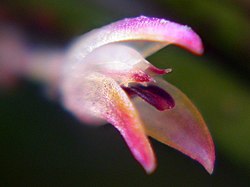| Anathallis microphyta | |
|---|---|
 | |
| Scientific classification | |
| Kingdom: | Plantae |
| Clade: | Tracheophytes |
| Clade: | Angiosperms |
| Clade: | Monocots |
| Order: | Asparagales |
| Family: | Orchidaceae |
| Subfamily: | Epidendroideae |
| Genus: | Anathallis |
| Species: | A. microphyta |
| Binomial name | |
| Anathallis microphyta (Barb.Rodr.) C.O. Azevedo & Van den Berg (2005) | |
| Synonyms | |
| |